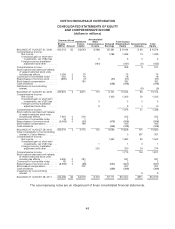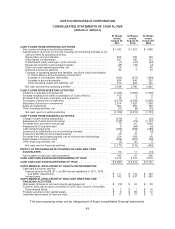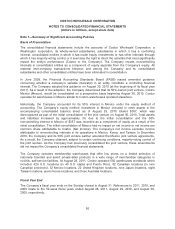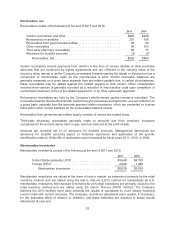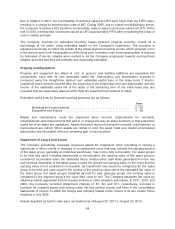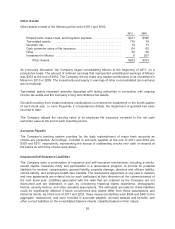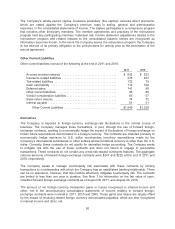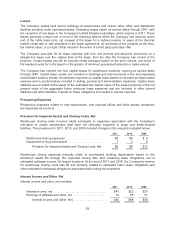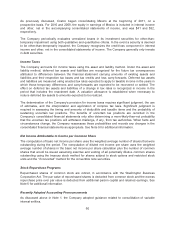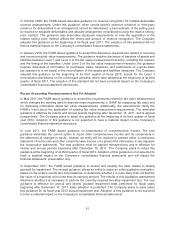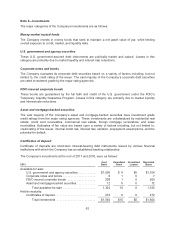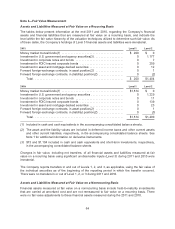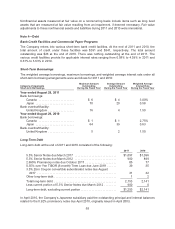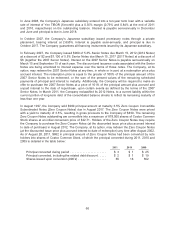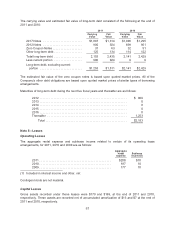Costco 2011 Annual Report Download - page 60
Download and view the complete annual report
Please find page 60 of the 2011 Costco annual report below. You can navigate through the pages in the report by either clicking on the pages listed below, or by using the keyword search tool below to find specific information within the annual report.The Company’s Executive Members qualify for a 2% reward (up to a maximum of approximately five
hundred dollars per year on qualified purchases made at Costco), which can be redeemed at Costco
warehouses. The Company accounts for this reward as a reduction in sales, with the related accrued
member rewards liability included in other current liabilities on the consolidated balance sheets. The
sales reduction and corresponding liability are computed after giving effect to the estimated impact of
non-redemptions based on historical data. The net reduction in sales was $790, $688, and $610 in
2011, 2010, and 2009, respectively.
Merchandise Costs
Merchandise costs consist of the purchase price of inventory sold, inbound shipping charges and all
costs related to the Company’s depot operations, including freight from depots to selling warehouses,
and are reduced by vendor consideration. Merchandise costs also include salaries, benefits and
depreciation on production equipment in certain fresh foods and ancillary departments.
Selling, General and Administrative Expenses
Selling, general and administrative expenses consist primarily of salaries, benefits and workers’
compensation costs for warehouse employees, other than fresh foods departments and certain
ancillary businesses, as well as all regional and home office employees, including buying personnel.
Selling, general and administrative expenses also include utilities, bank charges, rent and substantially
all building and equipment depreciation, as well as other operating costs incurred to support
warehouse operations.
Marketing and Promotional Expenses
Costco’s policy is generally to limit marketing and promotional expenses to new warehouse openings,
occasional direct mail marketing to prospective new members and direct mail marketing programs to
existing members promoting selected merchandise. Marketing and promotional costs are expensed as
incurred and are included in selling, general and administrative expenses in the accompanying
consolidated statements of income.
Stock-Based Compensation
Compensation expense for all stock-based awards granted is recognized using the straight-line
method. The fair value of restricted stock units (RSUs) is calculated as the market value of the
common stock on the measurement date less the present value of the expected dividends forgone
during the vesting period. The fair value of stock options is measured using the Black-Scholes
valuation model. While options and RSUs granted to employees generally vest over five years, all
grants allow for either daily or quarterly vesting of the pro-rata number of stock-based awards that
would vest on the next anniversary of the grant date in the event of retirement or voluntary termination.
The historical experience rate of actual forfeitures has been minimal. As such, the Company does not
reduce stock-based compensation for an estimate of forfeitures because the estimate is
inconsequential in light of historical experience and considering the awards vest on either a daily or
quarterly basis. The impact of actual forfeitures arising in the event of involuntary termination is
recognized as actual forfeitures occur, which generally has been infrequent. Stock options have a
ten-year term. Stock-based compensation expense is predominately included in selling, general and
administrative expenses on the consolidated statements of income. See Note 7 for additional
information on the Company’s stock-based compensation plans.
58


